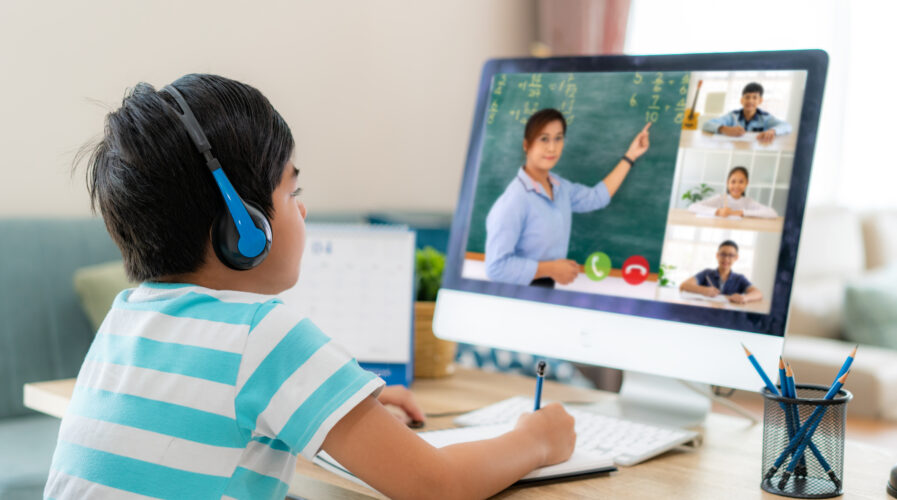
Source – Shutterstock
What is the future of education looking like in Asia Pacific?
- The ability of educators to provide students with a consistent, interesting learning experience across hybrid modalities of instruction will be crucial to the success of education in Asia Pacific in the future
- Existing curriculum should not be moved online in a wholesale manner, but adapted to bite-sized material
The concept of traditional education has drastically changed over the last several years, and even more so during the pandemic, shedding light on what the long-term future of education may include. Being physically present in a classroom is no longer necessary to learn thanks to the growth of the internet and innovative technologies like video conferencing systems and smart whiteboards.
Nowadays, getting good education whenever and wherever one chooses is made possible as long as one has access to the internet.
According to Zoom Lessons and Education report in collaboration with IBRS at the Zoom APAC Education Summit 2022, there is an urgent need for institutions throughout Asia Pacific (APAC) to prioritize professional development for educators in utilizing technology for teaching. The survey also showed that digital platforms have a dual function in aiding educators’ learning processes.
“The schools that did a really good job of transitioning straight into hybrid learning amid the pandemic, had a digital mindset. And that takes on a particular nuance. It’s not just about applying technology to different components of the education experience separately, but building an integrated digital ecosystem that consolidates systems for students and teachers for greater efficiency,” said Dr. Joe Sweeney, IBRS Advisor.
However, Sweeney believes that the most important lesson is that the way curriculum is developed and created, whether it is for young kids as early as year 1 or as late as university, needs to change.
“Existing curriculum should not be moved online in a wholesale manner, but adapted to bite-sized material that can be moved and slotted flexibly within the overall curriculum. Educators will also be able to share content more readily with each other, which drives peer review and improves teaching practices,” he explained.
Future-proofing education in a hybrid environment
The report also discovered that long instructional phases covering many academic focuses frequently led to students feeling disinterested in a distance learning environment. Learning phases should be more succinct and focused. It is advised to have three phases: a discovery phase for independent learning, a mentorship tutorial phase, and a synthesis phase for knowledge assessment.
Key findings from the report:
- In a hybrid classroom, students learn in a variety of locations. Future learning environments must also take into account parents who supervise their children’s education at home, hybrid teachers and administrators, and other stakeholders.
- All elements of education must be integrated into the technological environment used by schools in a way that is simple, user-friendly, and economical. This should apply to all aspects of student, teacher, and parent collaboration, including curriculum development and learning management.
- The formal technological architecture that can support educational innovation for improved teaching and learning experiences is something that educational institutions should be looking to in the future.
According to Sweeney, the pandemic has shown the education industry’s extreme adaptability, especially how rapidly institutions were able to use digital resources to give students a consistent, accessible learning experience.
“To help educators manage these ever-changing modes of learning, it will be key to integrate the different digital solutions and platforms into one cohesive ecosystem that can accommodate both in-person and virtual mediums of instruction,” he added.

Zoom’s Head of APAC, Ricky Kapur and Dr. Joe Sweeney, IBRS Advisor (Source – Zoom)
Education in Southeast Asia
The education sector is undergoing a transition, especially as technology increasingly dominates the field. Several ASEAN nations, including Indonesia and Malaysia, are using technology to improve education.
Indonesian students for example are among those who use technology in the classroom the most globally, claims Medium. More than most other students in the world, Indonesian students use technology in the classroom, with 40% of classrooms having IT suites or computer rooms. In addition, Indonesian students use desktop computers at a rate of 50%, which is second only to American students worldwide.
Overall, it is extremely likely that the education sectors in the region will gradually move away from the traditional method of teaching using markers and whiteboards, and more of utilizing PowerPoint presentations, and software to clarify concepts.
Zoom’s Head of APAC, Ricky Kapur, stated that the company has always supported making education available to all people. “This means supporting educators with the right technological platform as they navigate the future of education in a post-pandemic environment, which may look different for each institution. As shown in our report with IBRS, communications technology is pivotal to allowing educators to deliver remote instruction more effectively, purposely and in a way that students feel optimally engaged,” he said.
READ MORE
- Ethical AI: The renewed importance of safeguarding data and customer privacy in Generative AI applications
- How Japan balances AI-driven opportunities with cybersecurity needs
- Deploying SASE: Benchmarking your approach
- Insurance everywhere all at once: the digital transformation of the APAC insurance industry
- Google parent Alphabet eyes HubSpot: A potential acquisition shaping the future of CRM


